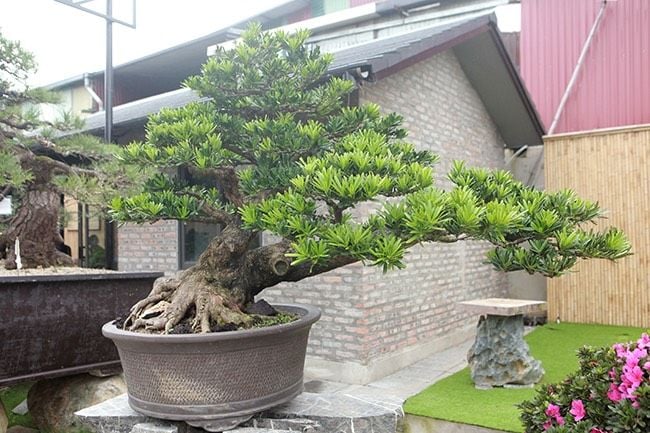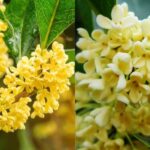Podocarpus macrophyllus
In the realm of feng shui, Podocarpus macrophyllus, commonly known as Buddhist Pine, is a prominent ornamental plant often favored by affluent families to adorn their entrances. Beyond its aesthetic appeal, this evergreen conifer holds symbolic significance, embodying prosperity and nobility.
The artfully crafted bonsai versions of these pines not only infuse spaces with a refreshing aura but also serve a pivotal role in warding off malevolent forces and attracting good fortune for the residents. This intrinsic allure prompts many affluent homeowners to incorporate these trees into their living environments, be it in compact gardens, spacious yards, or indoor settings.
Buddhist Pines are characterized by their slow growth rate yet impressive longevity, transforming them into invaluable assets over time. They are often deemed “wealth-storing trees,” with aged specimens becoming emblems of affluence, making them coveted investments.
Apart from their visual allure, these pines hold a special place in cultural heritage, often passed down through generations as tokens of hope and blessings. Ancient Buddhist Pines hold not only monetary value but also profound sentimental worth, forging enduring bonds between descendants, bestowing upon them prosperity and serendipity in life.

Transcending mere ornamentation, the Buddhist Pine is imbued with intergenerational significance, passed down through lineages as a harbinger of hope and prosperity.
Magnolia Trees
In the realm of traditional feng shui, Magnolia trees, scientifically known as Magnolia, have long been integral components of the gardens of the elite, especially among officials. Magnolia trees not only grace landscapes with their elegant presence but also impart distinctive feng shui attributes.
Magnolias are perennial trees that can tower between 2 and 30 meters high. Their leaves are oval-shaped, don a deep shade of green, and typically grow in an alternating pattern, forming a lush canopy. As winter sets in, these leaves bid farewell, revealing buds awaiting their moment to flourish. When the leaves depart, Magnolias flaunt their grandeur with sizable blooms measuring 12 to 15 centimeters in diameter. Their petals are thick, lustrous, and diverse in hues, ranging from pink, yellow, and white to purple. Notably, these blossoms endure, retaining their beauty for up to a month.
With the advent of spring, Magnolia buds unfurl like ethereal beings, gradually blossoming and exuding a delicate fragrance that infuses the surroundings with vitality and elegance. In the context of feng shui, Magnolia flowers aren’t merely aesthetic embellishments; they symbolize prosperity and nobility. Many households plant Magnolias near their entrances, aspiring to entice wealth and good luck, thereby fostering prosperity in both business endeavors and domestic life.
Moreover, Magnolia flowers are emblematic of authority and status. When guests arrive, they are instantly captivated by the allure of the Magnolia, forming a positive impression of the homeowner. For optimal growth, Magnolias thrive in spaces bathed in ample sunlight and fresh air, conditions that encourage their flowering propensity.
To ensure robust development, judicious fertilization is essential. Slow-release fertilizers provide trees with the requisite nutrients throughout their growing season, setting the stage for successive blooming cycles. Within the feng shui paradigm, Magnolias transcend ornamental plants; they signify wealth, prosperity, and power, attracting auspiciousness for the residents.

In the realm of feng shui, Magnolias are more than just ornamental trees; they symbolize wealth, prosperity, and the power that emanates from a life well lived.
Malus Spectabilis
Malus spectabilis, commonly known as Chinese Crabapple, boasts a rich historical significance in Eastern culture, encapsulated in the proverb, “Malus spectabilis dwelling in the house brings natural wealth and honor.” Since ancient times, this flowering tree has been an indispensable fixture in the gardens of aristocrats and affluent families.
Dubbed the “Princess Flower,” Malus spectabilis captivates with its graceful demeanor and abundant blooms. When spring arrives, the tree bursts into a vibrant display, becoming the focal point of any setting. Upper-class families often cultivate this species to relish the invigorating spring atmosphere and harvest its fruits come autumn. The fruits of the Chinese Crabapple offer a delightful sweet-and-sour flavor and are particularly prized for their use in jams.
In the context of feng shui, the presence of Malus spectabilis at the doorstep of a home is a telltale sign of a prosperous family with stable finances and a life of abundance. Notably, with its diverse cultivars, this tree can be trained into a bonsai, adding a touch of refinement and subtlety.
Malus spectabilis is regarded as a harbinger of gold and jewels, symbolizing status and wealth. Tending to this tree within the home isn’t merely about attracting wealth; it also signifies welcoming good luck. Furthermore, the tree contributes to air purification, helping to eliminate pollutants and fostering a healthier living environment.
Malus spectabilis thrives in sunlight, hence the preference for sunny locations that ensure sufficient light exposure. During the tree’s formative years, light and frequent fertilization encourage profuse flowering, imbuing spaces with dynamism and vitality. In essence, Malus spectabilis transcends ornamental value, assuming the role of a pivotal feng shui symbol that attracts wealth and serendipity for the entire family.
Disclaimer: Information provided is for reference only and not intended for fortune-telling purposes.



































